How is the US population changing?
Household size, racial demographics, the average age of an American: these stats are always changing. And who has a college degree? How many people are registered to vote? Here’s America by the numbers.
Up Next
Transcript
In this episode of Just the Facts: America by the Numbers.
The Ancient Greeks said, you must know thyself. So, let's get to know this great country we call home.
The United States of America is a vast country at 3.8 million square miles. A square mile, by the way, is about 484 football fields all crammed together.

We are the third largest country by area in the world, behind whom? Russia. And guess who else? China? Brazil. No. The answer is actually our neighbors up north. Canada is the second largest country by area.

Across our 3.8 million square miles we have 4 million miles of roads, 63 national parks, and 37% of all of that land is owned by the government. Federal, state, local.

According to the US Census Bureau, there were nearly 337 million people in the US as of July 2024, which is 4% of the world's population, which is just over 8 billion.
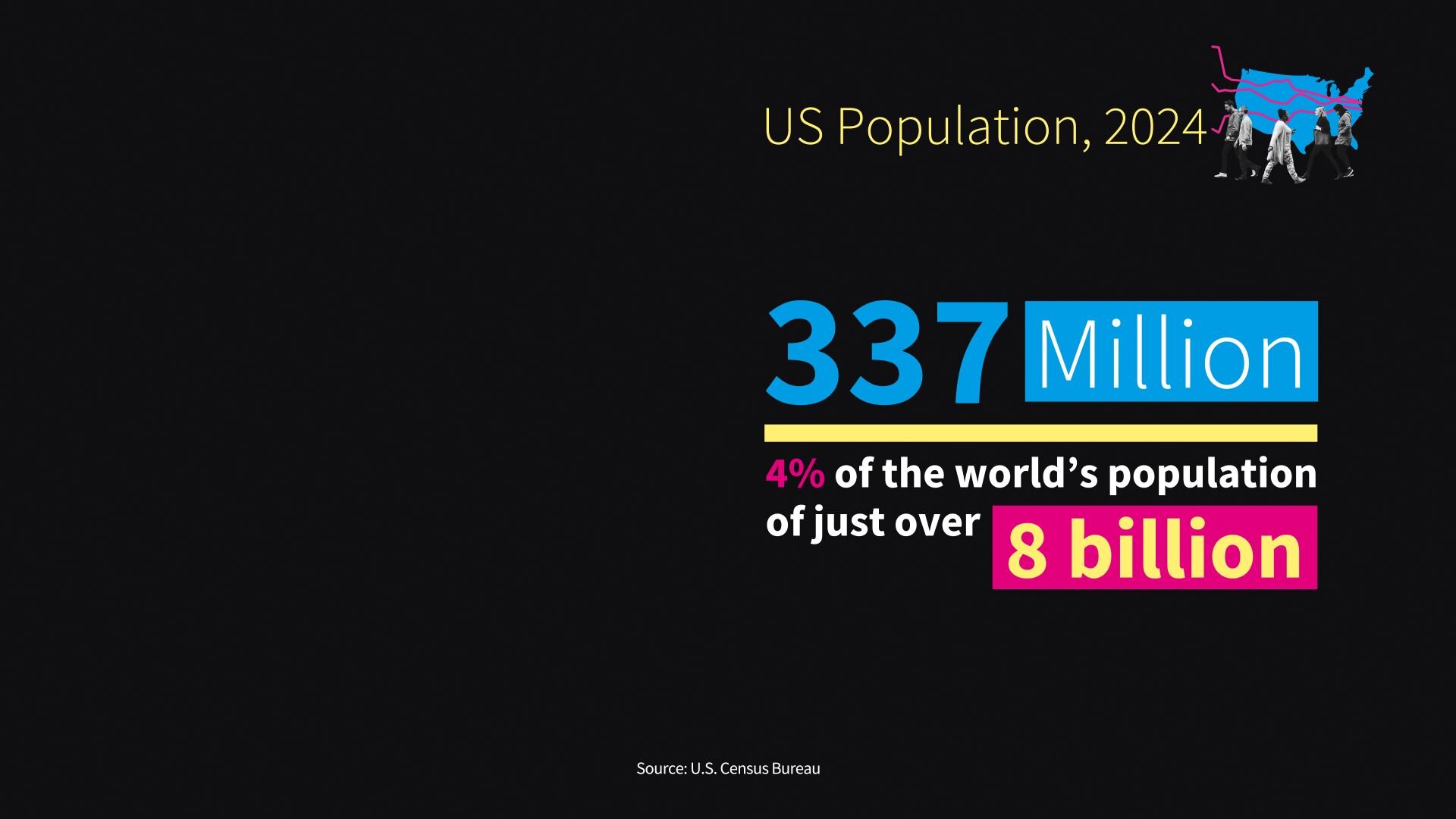
Our population grew by 1.6 million people in 2023, 69% of that, or 1.1 million people, was from net migration into the country and back out, while the remaining 500,000 came from more babies being born than for people dying in the country.
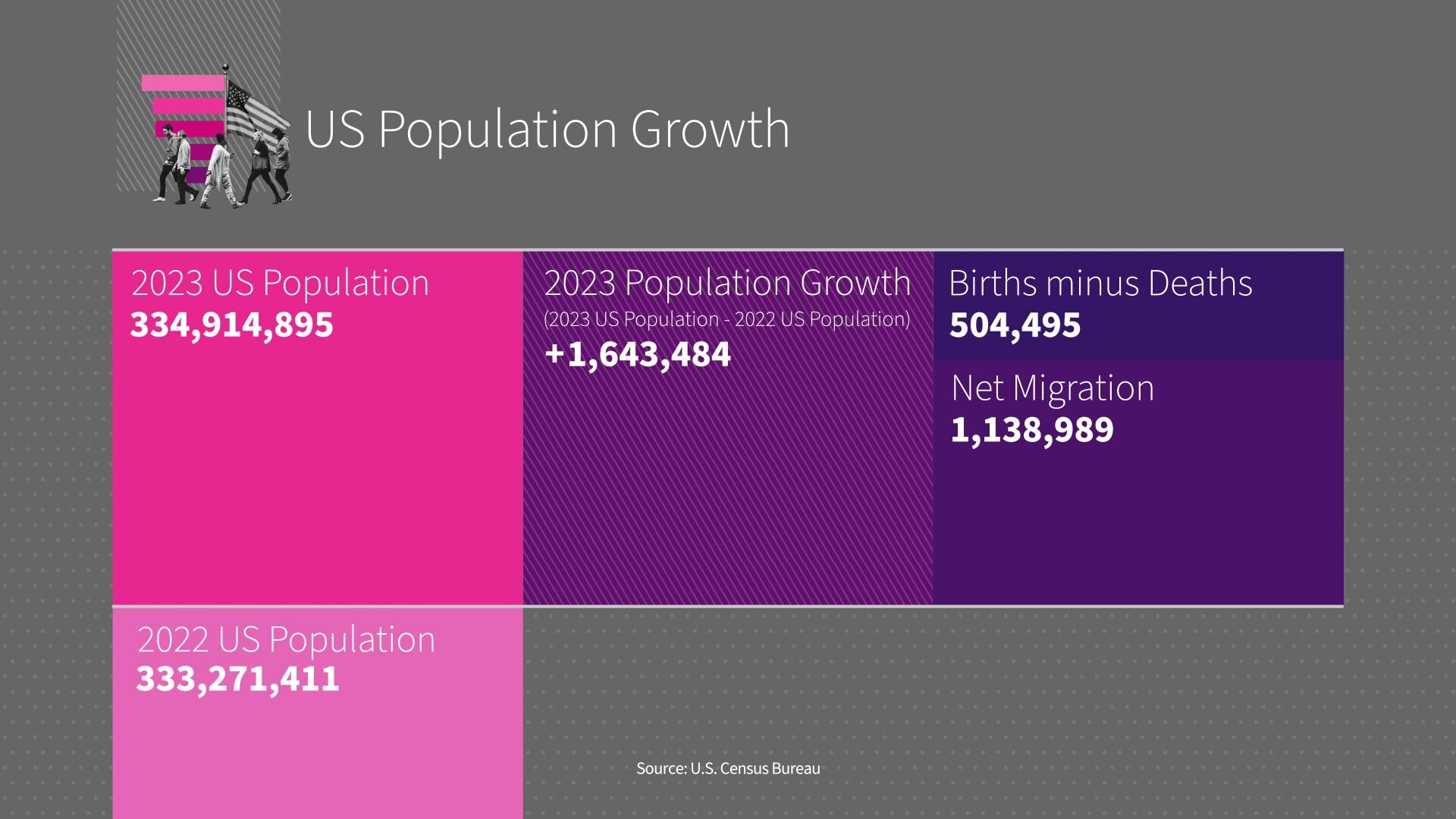
The total US population growth rate in 2023 was only 0.5%. Low by historical standards, but higher than the last three years during Covid. By contrast, that number was 1% in 1980. The growth rate has really declined. Our number of births fell to its lowest level since 1979.

Now let's take a look at who we are.
22% of our country’s population was 17 years old or younger. 36% were adults aged 18 to 44, 25% were 45 to 64 years old, and 18% of us were over 65. And I can say “us.”
And just think, in 1980, seniors were 11.3% of our population and now account for 18%. Wow. And people under 18 were 28% back then, but now it’s down to 22%. That’s a huge change in the world of demographics. Kind of blows my mind.

Meanwhile, the composition of US households has also shifted. Married parent households have fallen from 31% of US households in 1980 to just 18% in 2023. Wow, that is so different than from my childhood.

At the same time, the share of households comprised of adults living alone without children increased from 23% to 29%. That’s also a big change in the world of demographics.

The percentage of married people with no kids at home has stayed relatively stable, between 28 and 29%. Now, single parent households with kids under 18 have also remained stable, around 7.5%.

There are now 10 million single parent family households, 75% of which are single mothers and 25% are single fathers.

However, in 1980 that dynamic was 90% single mothers and 10% single fathers.

One fact that will likely ring true to many of you, 58% of men and 55% of women aged 18 to 24 lived in their parent's home in 2023.
For men, that’s actually a six percentage point increase since 1960. But the share of young women living at home is up 20 percentage points.
Even more interesting is the 25 to 34 year old age group, where 20% of men live with their parents, up from 11% in 1960. And 12% of women live with their parents, up from 7% in 1960.
That's really interesting to me. Most of this growth has happened since 2008, and people are getting married later in life.

Our country has also gotten more diverse. The principal change has been the growth of the Hispanic and Asian populations. In 1990, Hispanics were 9% of the population and now comprise 19%. The Asian population went from 3% to now 6%. The black population made up 12% of the total in 1990 and is 13% today.

The US Census Bureau found that the median age for marriage in 1980 was 22 for women, and close to 25 for men. In 2023, it was 28 years old for women and 30 years old for men. Another big demographic shift.
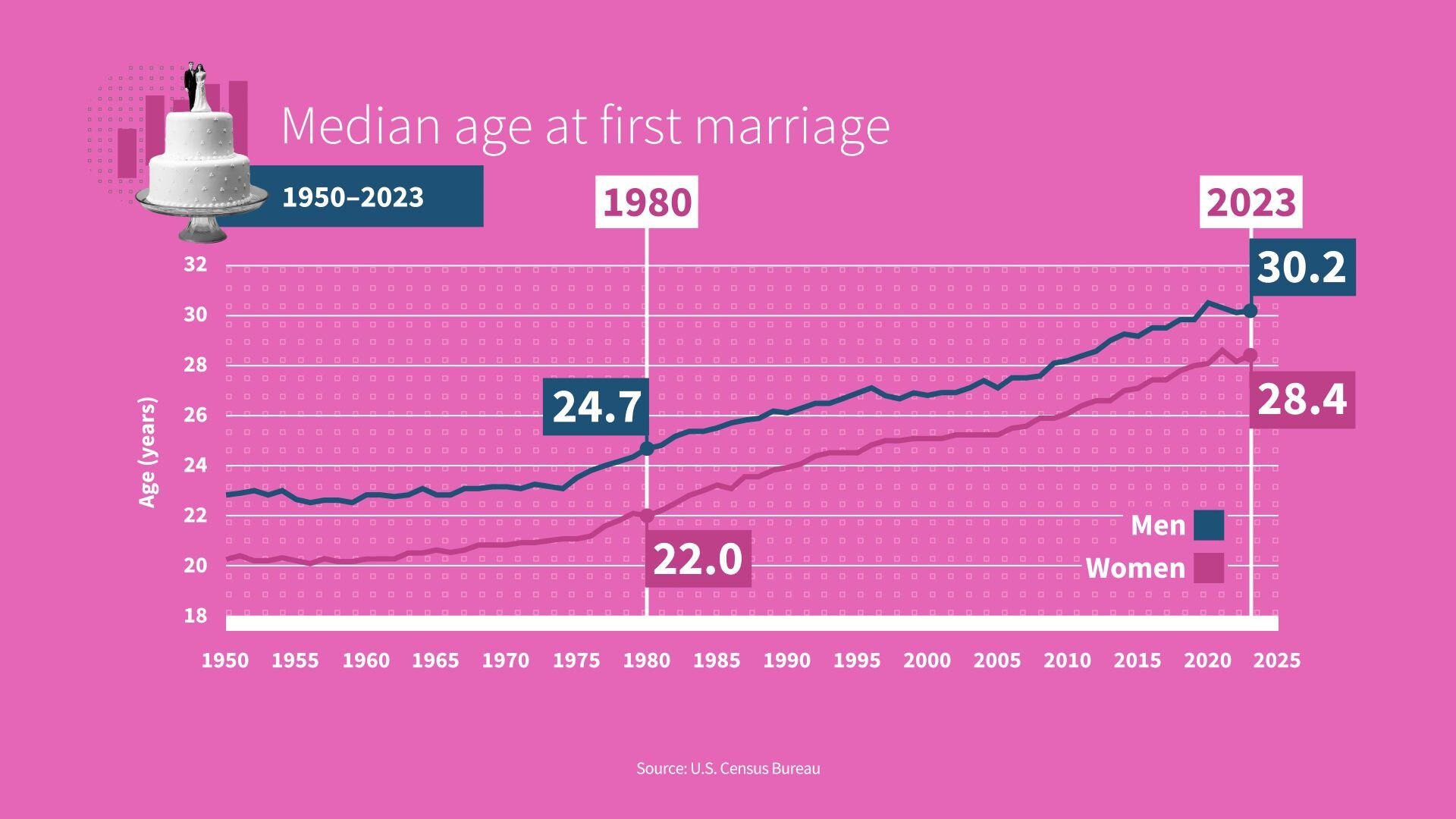
Let's look at six different groups of people based upon Census Bureau data.
First, let’s look at people who identify as white but not Hispanic. About 195 million people. Then there are people who identify as white, who also identify as Hispanic. That's over 56 million people. Black people who identify as non-Hispanic, 42 million people. And then Black people who identify as Hispanic are 3.4 million people. Asians, 21 million people plus, and all other people in the US, close to 16 million.
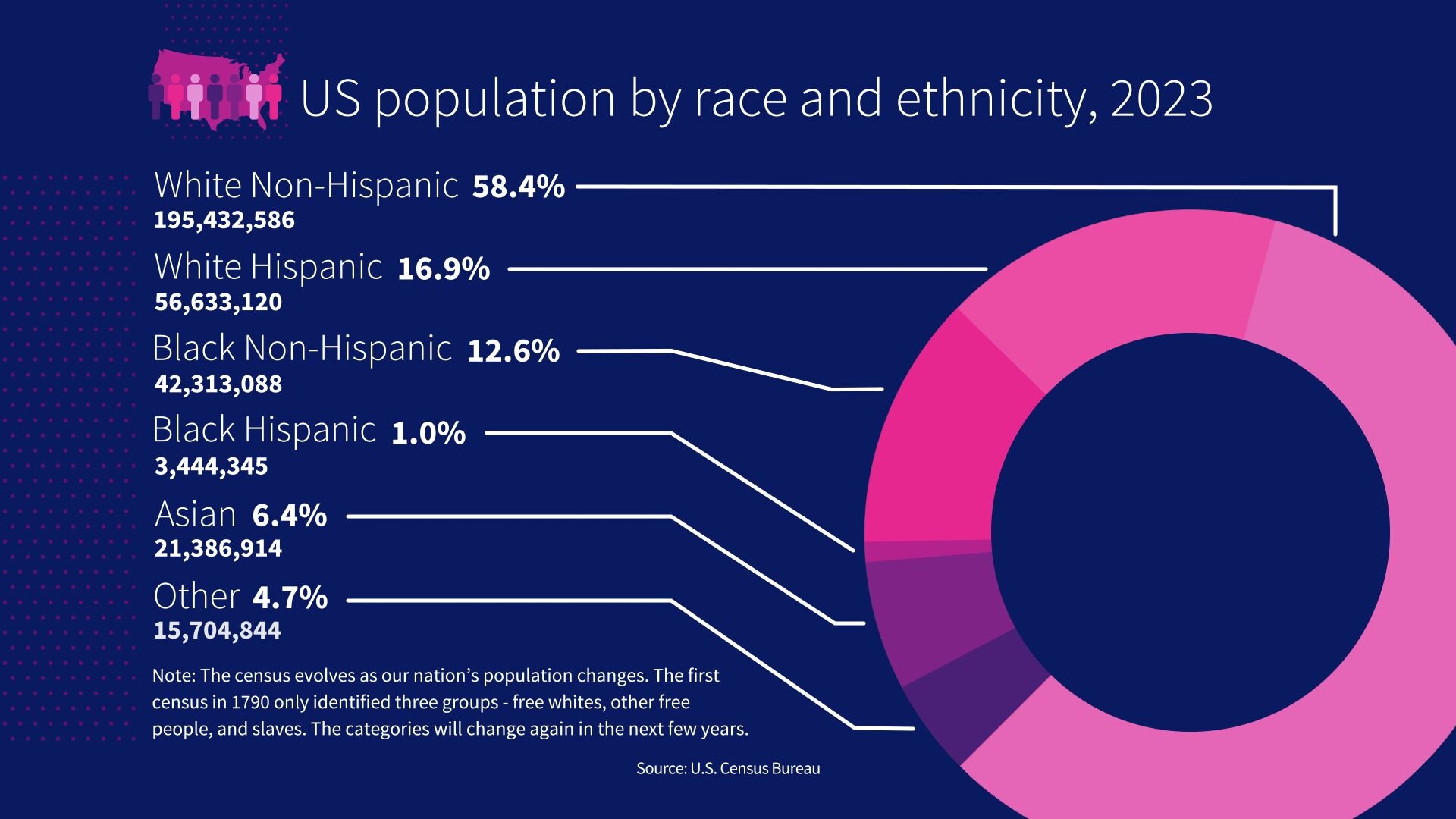
The Census Bureau does evolve how it presents the nation's population as time goes by. The first census in 1790 only identified three groups: free whites, other free people, and slaves.
The categories will change again in the next few years. In recent decades, there have been notable changes in not only who we are, but where we live.
Here’s a fun fact to follow the overall trends of population changes between states, we can actually just look at the number of congresspeople assigned to each state, and how that has changed over time.
Currently, every congressional district includes approximately 760,000 people. Since 1980, the biggest winners or growers, if you will, have been states like Texas, with an increase of 11 members of Congress.
The biggest losers relatively in population are states like New York, who lost eight Congress people. Looks like a lot of people have decided they prefer warm weather and sunshine. Not me. I’ll stick with Seattle.

Household income includes income from work and from investments you might own. Income includes government benefits paid, but it does not include non-cash government assistance like health insurance, Medicaid, Medicare, food assistance like Snap, subsidized housing or other similar programs.
Median household income has risen over time. From 1984 to 2013, it rose by about $9,000 before increasing sharply from 2014 to 2019 to $78,250 per household, and then fell in the last few years back to $74,580. All of those numbers were adjusted for inflation. In 2022, the median income for white, non-Hispanic households was just over $81,000. For black households, it was 35% less at $52,000 plus, for Hispanic households, it was $62,000 plus, which is 23% less than white non-Hispanic households.

Asian households had the highest household income at just under $109,000. Maryland, Washington, DC, and Utah have the highest median household incomes in the country. The lowest are in Mississippi, West Virginia, and Arkansas.
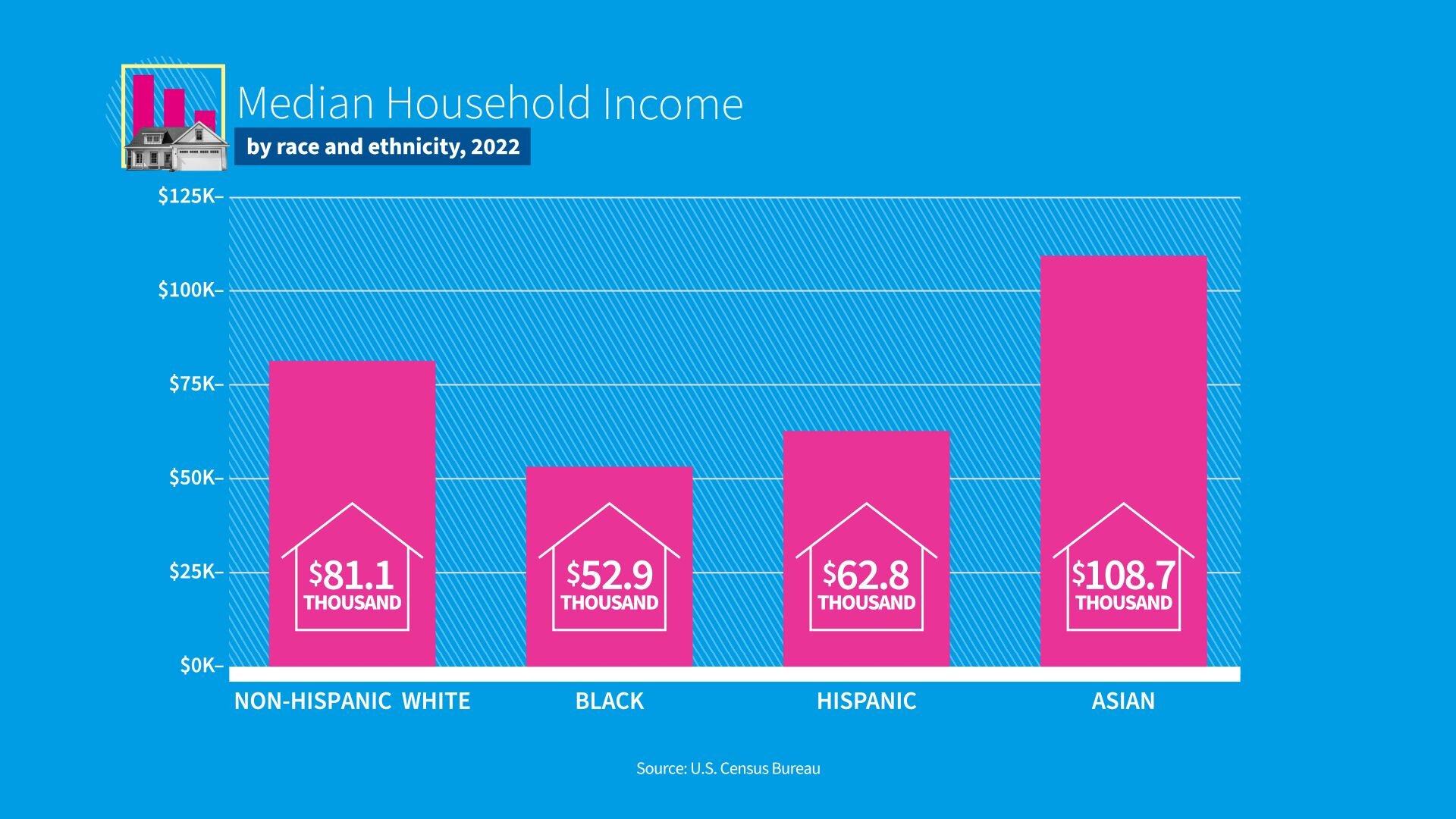
Now let's take a look at education. In 2022, among those 25 or older, 9% had less than a high school diploma or equivalent. 28% of people had high school graduate as their highest level of school completed. 15% of people had completed some college, but not a degree, 10% had an associate degree, 23% had a bachelor’s degree, 14% had actually completed an advanced degree, such as a masters, a professional certification, or a doctoral degree.

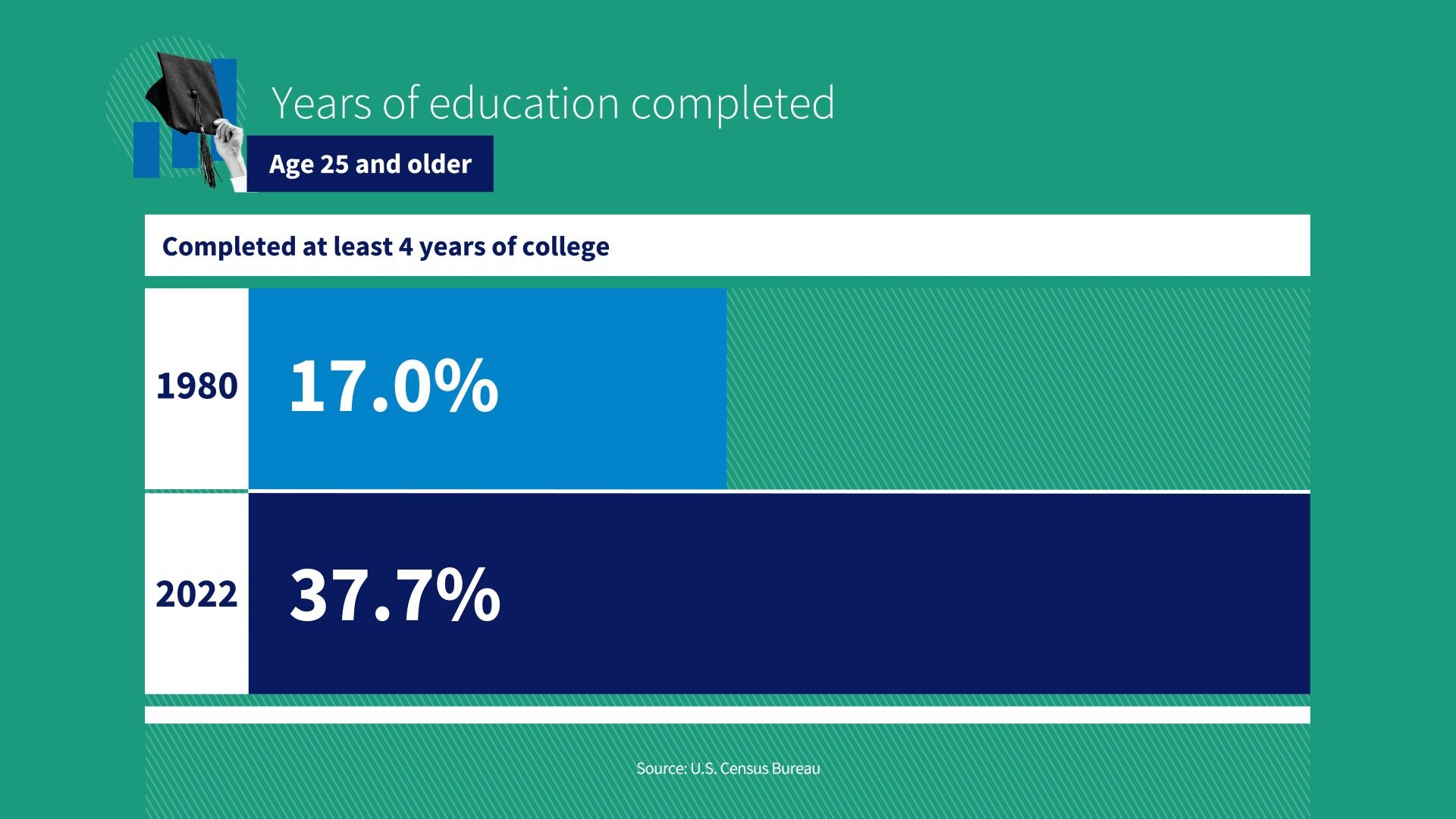


Now let's take on this question: is college worth it?
The weekly median earnings for a person with a bachelor's degree is $1,500, and for people whose highest level of education is a high school diploma, it's only $900. College is not for everyone, but on average, it pays.

Let’s talk about how our kids are doing in school. Between 1990 and 2022, math proficiency increased from 15% to 26% among eighth graders and from 13% to 36% among fourth graders. I love the improvement. I think the scores are overall lower than at least I would hope for as a citizen.
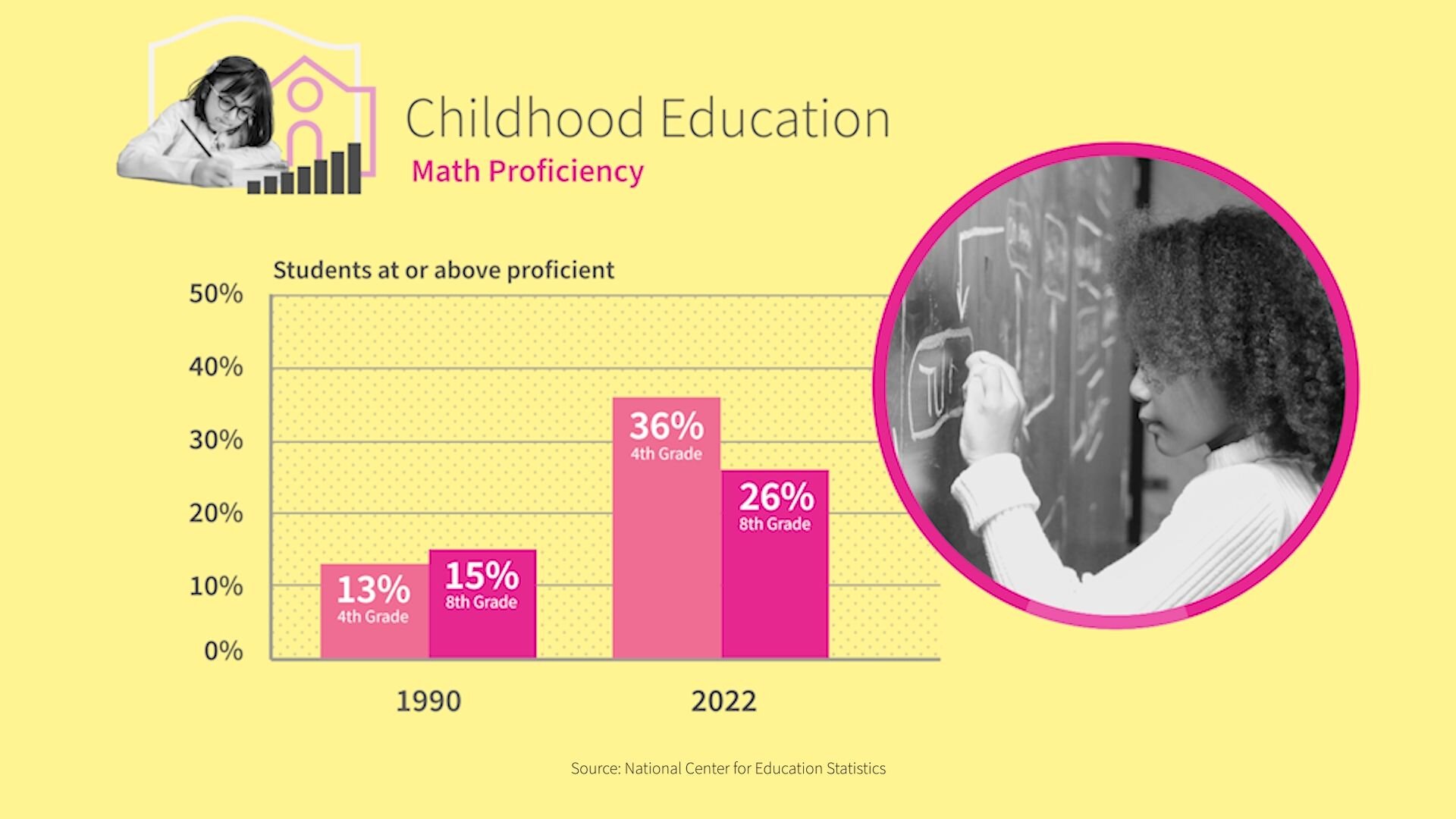
Reading proficiency began being measured in 1992 and has barely increased at all, from just over 29% to 31% for eighth graders and 29% to 33% among fourth graders.

All test scores peaked between 2013 and 2017, and have declined some since.

For example, fourth grade math proficiency peaked at 42% in 2013, but now we see it at 36%.
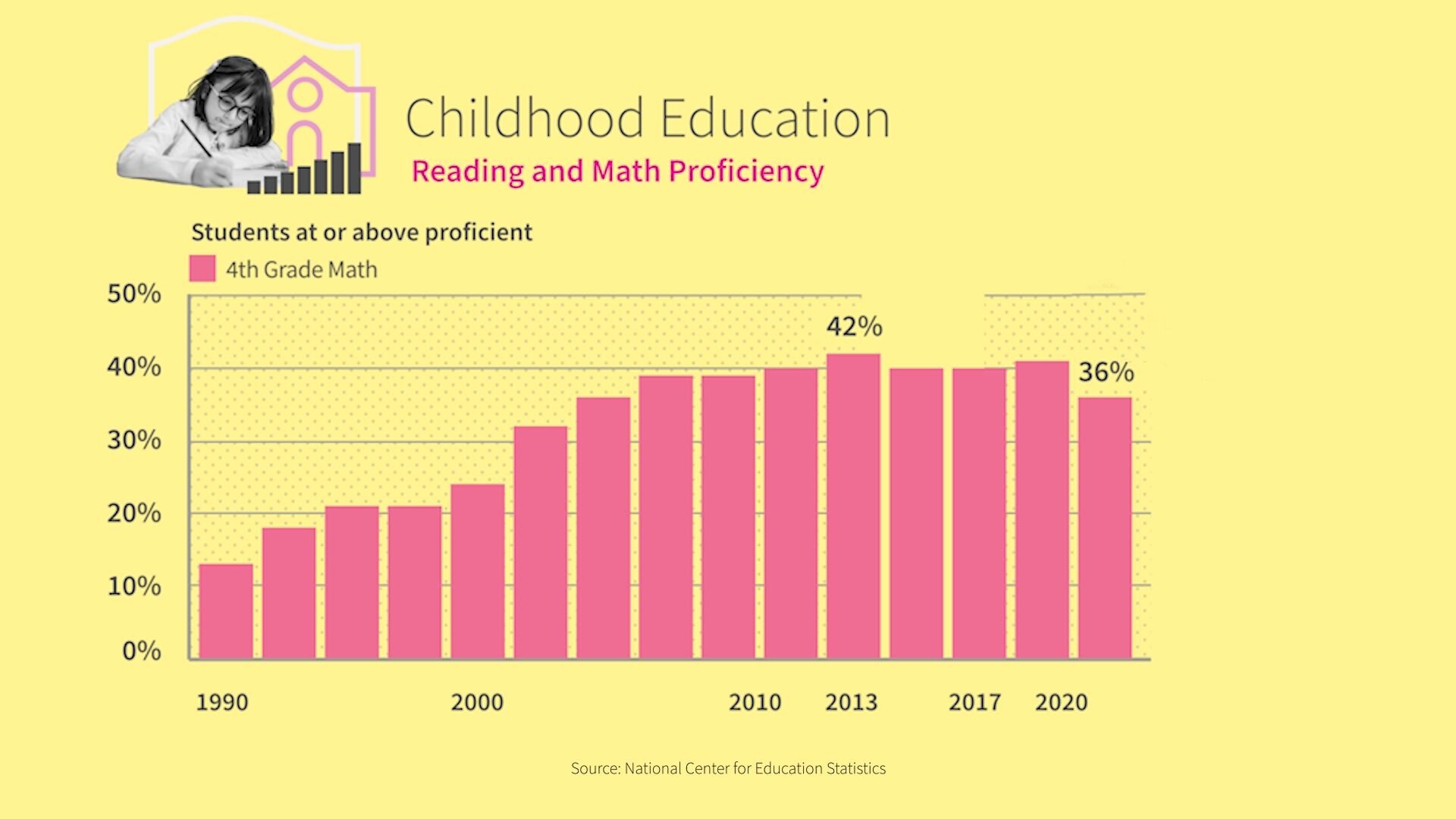
To me, that’s the wrong direction. Here’s my view. As a nation, it just isn’t acceptable where we are. And there are a lot of factors that go into these scores, not just what goes on in the classroom, but we need to do better.
Let's take a bit of a look at what Americans do for a living. First of all, reference: 161 million Americans are working. In 2022, there were 20.9 million people working for our government. 79% worked for state and local government, and 21% worked for the federal government.

In the private sector, the largest occupations in the United States in order are... 1: Home health and personal care aides. That makes sense as we get older, as our population is the oldest it has ever been, jobs have been created to take care of our elderly.
Retail salespersons, number 2. Number three fast food and counter workers. Number four are management job: general management and operations management. Next, cashiers. Registered nurses, laborers and freight stock and material movers by hand. A big group. All of these occupations had between 3 and 4 million people working in them in 2023.

As an example of how some of these things have changed, in 1990, there were over 2 million people in active duty military. But by 2023, that number had decreased to 1.3 million people. Another good example: in 1990, there were 2.6 million public K-12 teachers, but by the 2021 school year, there were 3.8 million teachers.
In 1993, there were 543,000 police officers with the power of arrest. And by 2022, there were 706,000. Now, keep in mind there are more students and people in the country each year. But to me, it was interesting that the military personnel has gone down.
Police have gone up some and school teachers have gone up quite a bit more. Food for thought in there.

Let's compare that to personal financial advisors: there are 272,000. Psychologists: 150,000. Zoologists: 17,000.

I’m sure it won’t surprise you that more Americans are working from home post-pandemic than pre-pandemic.

Washington, DC, had the most remote workers in 2022. Mississippi and North Dakota had the least.
For those who still commute to work, the average commute time is 26 minutes.

Less than 1% of people ride a bike to work. 2% walk to work. 3% only take public transportation to work. While 69% of people drove alone. And that's by far the most popular form of commuting in the United States.

92% of households in the US had at least one car available to them in 2022. Actually, 37% had access to two cars and 22% had access to three or more.

3.3 trillion miles were driven in 2023, compared to 1.5 trillion in 1980. That's an increase of 115% over time when the population only grew 47%. We are driving more.

Let's talk about technology. In 1980, no one had an internet subscription. The consumer internet didn't exist. It was just something for scientists and researchers.
In 2023, 96% of US households had at least one type of computer and 92% had a broadband internet subscription. Smartphones were the most common computing device in US households. Uh, of course. 92% of households have at least one, followed by 80% of households who have one or more desktop or laptop computers and 64% with tablets.
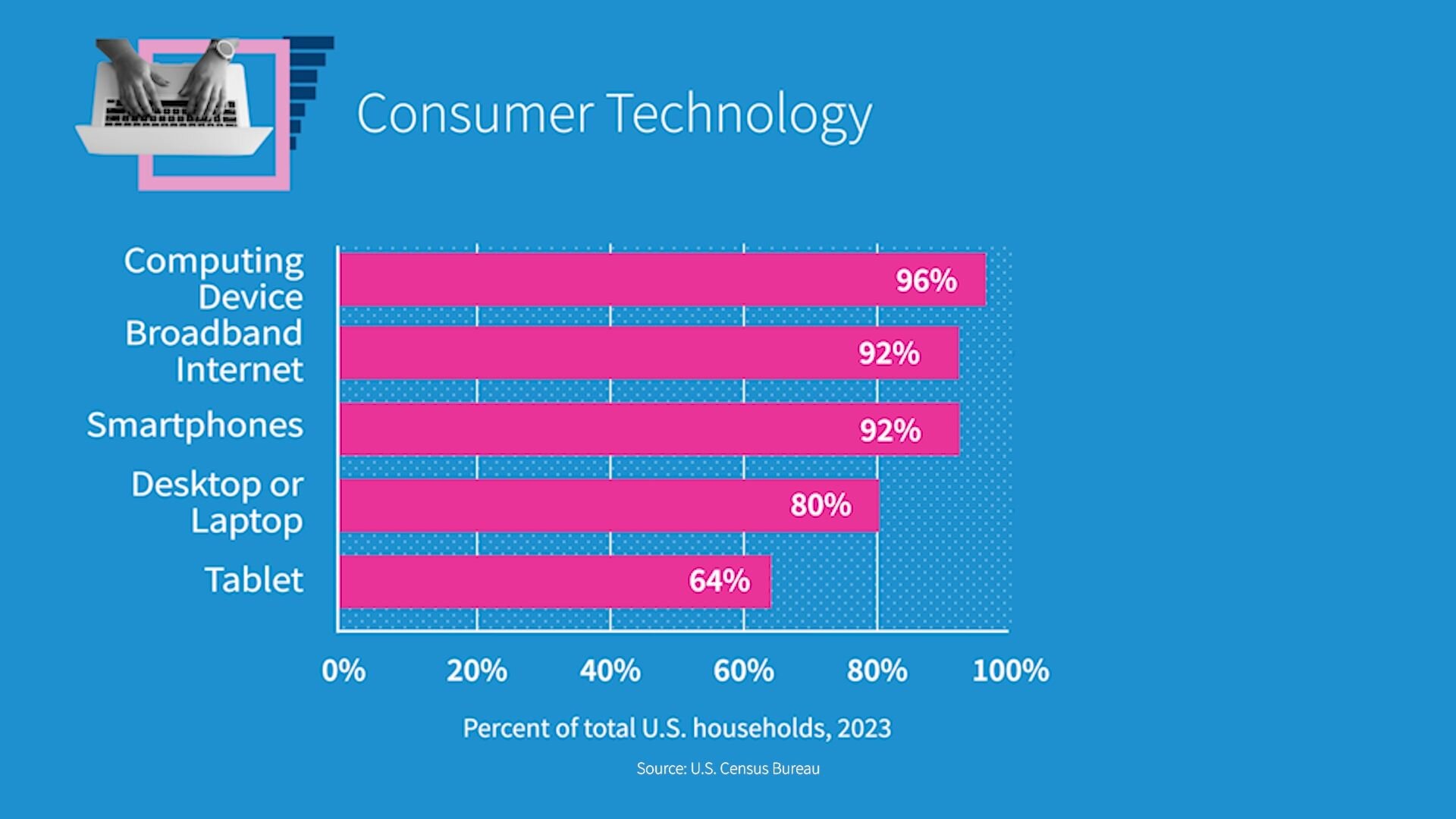
Here is a fun fact: Americans gamble. We spent approximately $98 billion on lottery tickets in 2022. I found this surprising. Massachusetts residents spend the most at $970 per capita, while North Dakota residents spent the least, just $37.
How about a little lightning round of other interesting facts about America?
- 16 million veterans in the country.
- 3 million active-duty soldiers.
- 67 million people on Medicare while there are 75 million people on Medicaid.
- 42 million people relied on food stamps as of 2023. 38 million people, unfortunately, were below the poverty line in 2022.
- 70 million people receive Social Security.
- Our life expectancy is about 77.5 years for someone born today, but the average age of death is 73 years.
- 1.2 million people were in prison in 2022. That doesn't include people who were in jail, typically for periods under a year.
- America has 880 million acres of farmland. That’s the size of Texas times five. In 2022, corn was our number one cash crop, followed by soybeans, fruits and nuts.
- After oil and gas, civilian aircrafts and parts are the country's biggest export.
- Our biggest exports specifically to China? Soybeans.
And finally, a word on our democracy.
The 2020 presidential election had the highest voter turnout of the 21st century, with 66.8% of citizens over 18 voting in the election. That's great.

As with past elections, a higher share of women than men turned out to vote. 68.4% of women, to 65% of men.

Voter turnout also increased as age, educational attainment, and income increased. Voter turnout was highest among those ages 65 to 74, at 76%, while the percentage was lowest among those aged 18 to 24, at 51%.

It's sure going to be interesting to see what those numbers look like this election cycle.
I've learned a lot from this. I hope you have too.
In this series, Just the Facts, we've covered the budget, immigration, health and health care, the economy, the environment, and these facts about America.
I hope you agree, the more we know, the better voters we can be. We'll give you just the facts. You decide what you believe.
Page sources and methodology
All of the data on the page was sourced directly from government agencies. The analysis and final review was performed by USAFacts.
Census Bureau
U.S. and World Population Clock and Data Tables
Central Intelligence Agency
The World Factbook
Our government is complex. Our data doesn’t have to be.
Subscribe to our weekly newsletter to get data-backed answers to today’s most debated issues

